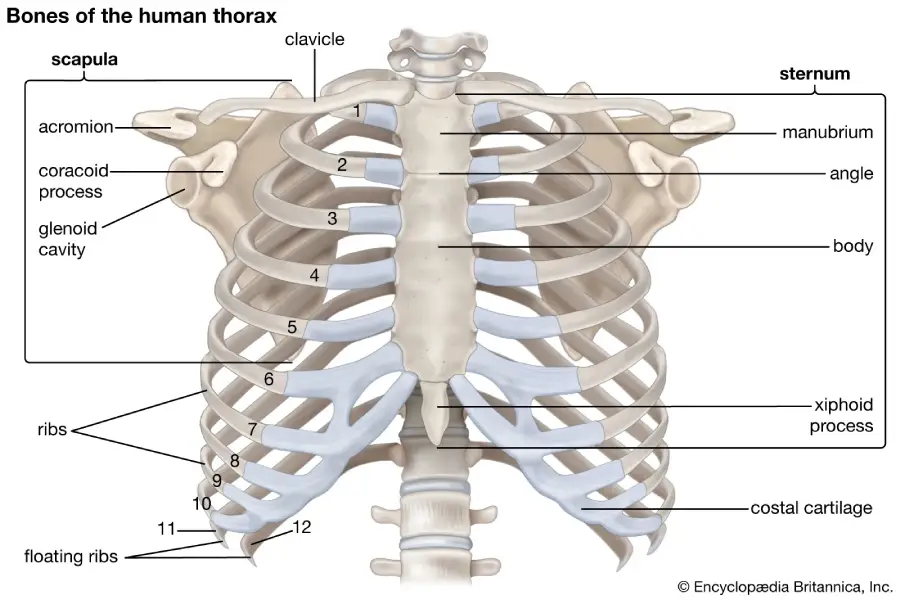The Human Thorax: Structure, Function, and Clinical Relevance

Abstract
The thorax, commonly referred to as the chest, is a vital anatomical region that houses and protects major organs, including the heart and lungs. It is comprised of the thoracic vertebrae, ribs, and sternum, forming a protective cage that supports respiration and other essential functions. This article provides an in-depth exploration of the bones of the thorax, their anatomical features, development, and clinical significance.
Introduction
The thorax plays a crucial role in human anatomy, serving as the central component of the upper body. It provides structural support, protects vital organs, and facilitates breathing. The bony structures of the thorax include the thoracic vertebrae, ribs, and sternum, collectively forming the thoracic cage. Understanding the anatomy and function of these bones is fundamental in medical science, particularly in fields such as cardiology, pulmonology, and trauma surgery.
Anatomical Structure
The bony framework of the thorax consists of 37 bones: 12 thoracic vertebrae, 24 ribs, and the sternum. These bones are interconnected by joints and cartilage, providing both rigidity and flexibility.
Thoracic Vertebrae
The thoracic vertebral column is composed of 12 vertebrae (T1-T12), each with distinctive features:
- Vertebral Body: The anterior portion, providing weight-bearing support.
- Vertebral Arch: Encircles the spinal cord, forming the vertebral foramen.
- Transverse Processes: Extend laterally, serving as attachment points for muscles and ligaments.
- Spinous Process: Projects posteriorly, offering additional muscle attachment sites.
- Articular Processes: Facilitate articulation with adjacent vertebrae.
Ribs
The rib cage consists of 24 ribs, arranged in 12 pairs:
- True Ribs (1-7): Directly attached to the sternum via costal cartilages.
- False Ribs (8-10): Indirectly connected to the sternum through the cartilage of the rib above.
- Floating Ribs (11-12): Not attached to the sternum, providing protection to the lower thorax.
Each rib has a head, neck, and tubercle:
- Head: Articulates with the vertebral bodies.
- Neck: Connects the head to the tubercle.
- Tubercle: Articulates with the transverse process of the corresponding vertebra.
Sternum
The sternum, or breastbone, is a flat, elongated bone located at the center of the chest. It consists of three parts:
- Manubrium: The upper portion, articulating with the clavicles and the first two pairs of ribs.
- Body: The elongated central portion, articulating with ribs 3-7.
- Xiphoid Process: The small, cartilaginous lower portion that ossifies with age.
Development
The bones of the thorax develop through a combination of endochondral and intramembranous ossification:
- Thoracic Vertebrae: Develop via endochondral ossification from cartilaginous precursors.
- Ribs: Initially form as cartilage and gradually ossify during fetal development and early childhood.
- Sternum: Forms through the fusion of multiple ossification centers, with the xiphoid process being the last to ossify.
Function
The thoracic cage serves several critical functions:
- Protection: Shields the heart, lungs, and major blood vessels from mechanical damage.
- Respiration: Provides attachment points for respiratory muscles, facilitating the expansion and contraction of the lungs.
- Support: Maintains the structural integrity of the upper body, supporting the shoulder girdle and upper limbs.
- Attachment: Serves as a site for muscle attachment, aiding in movements such as breathing, lifting, and twisting.
Clinical Relevance
The bones of the thorax are involved in various clinical conditions and injuries:
- Fractures: Rib fractures are common in trauma and can lead to complications like pneumothorax.
- Osteoporosis: Decreased bone density can lead to vertebral compression fractures.
- Thoracic Outlet Syndrome: Compression of neurovascular structures at the thoracic inlet, often involving the first rib.
- Scoliosis: Abnormal curvature of the spine can impact the thoracic cavity and respiratory function.
- Pectus Excavatum: A congenital deformity of the sternum, resulting in a sunken chest appearance, potentially affecting cardiac and pulmonary function.
Conclusion
The thorax’s bony structure is a complex and essential component of human anatomy, playing a vital role in protection, support, and respiration. A thorough understanding of the thoracic bones is crucial for diagnosing and treating various medical conditions and injuries. Advances in medical imaging and surgical techniques continue to enhance our ability to manage thoracic disorders, improving patient outcomes.
References
- Standring, S. (2020). Gray’s Anatomy: The Anatomical Basis of Clinical Practice (42nd ed.). Elsevier.
- Moore, K. L., Dalley, A. F., & Agur, A. M. R. (2013). Clinically Oriented Anatomy (7th ed.). Lippincott Williams & Wilkins.
- Sadler, T. W. (2018). Langman’s Medical Embryology (14th ed.). Wolters Kluwer.
- Goss, C. M. (2010). Anatomy of the Human Body. Lea & Febiger.
- Carlson, B. M. (2014). Human Embryology and Developmental Biology (5th ed.). Elsevier.
🎓 Want to become a certified instructor?
This lesson is part of our FREE Anatomy course. Create a free account to track your progress and earn your certificate!